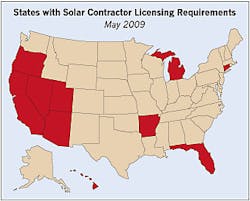License for Renewable Energy Installation
With the renewable energy industry expected to generate more than 20 million jobs by 2030, many electrical contractors are hoping to stake out their territory in the renewable energy market. Who better to retrofit electrical systems in buildings for energy efficiency and install and wire solar panels and wind turbines than those already in the electrical business?
“You don't need to train a separate workforce when you already have a highly trained pool of electricians who need minimal training to become qualified solar installers,” says Kim Craft, assistant business manager for Los Angeles Local 11.
But not so fast. Although the International Brotherhood of Electrical Workers (IBEW) claims to have the curriculum, facilities, and instructors needed to lead the new energy revolution — more than 70 IBEW training centers offer training in renewable energy, with more facilities incorporating green power into their curriculum — there are still the separate issues of licensing and certification.
In some states, solar is a specialty classification under the general electrical or plumbing licenses, and all appropriately licensed contractors can install solar systems without the solar specialty license, according to the Database of State Incentives for Renewables and Efficiency (DSIRE) Solar Web page. However, 10 states and Puerto Rico require solar installers to earn a specialized solar contractor's license separate from an electrical contracting or plumbing license. In addition, certification by the North American Board of Certified Energy Practitioners (NABCEP), Clifton Park, N.Y., is often required by rebate programs, even in states that do not have special licensing mandates. For instance, the Pennsylvania Department of Energy requires solar contractors used in its rebate program to be NABCEP certified.
For more information on solar licensing and certification in your area, visit the DSIRE database at http://www.dsireusa.org/solar/. For more information on NABCEP certification, visit the organization's Web site at http://www.nabcep.org/.
